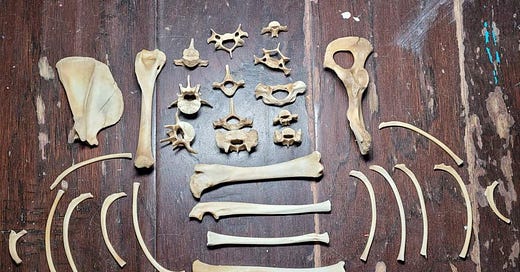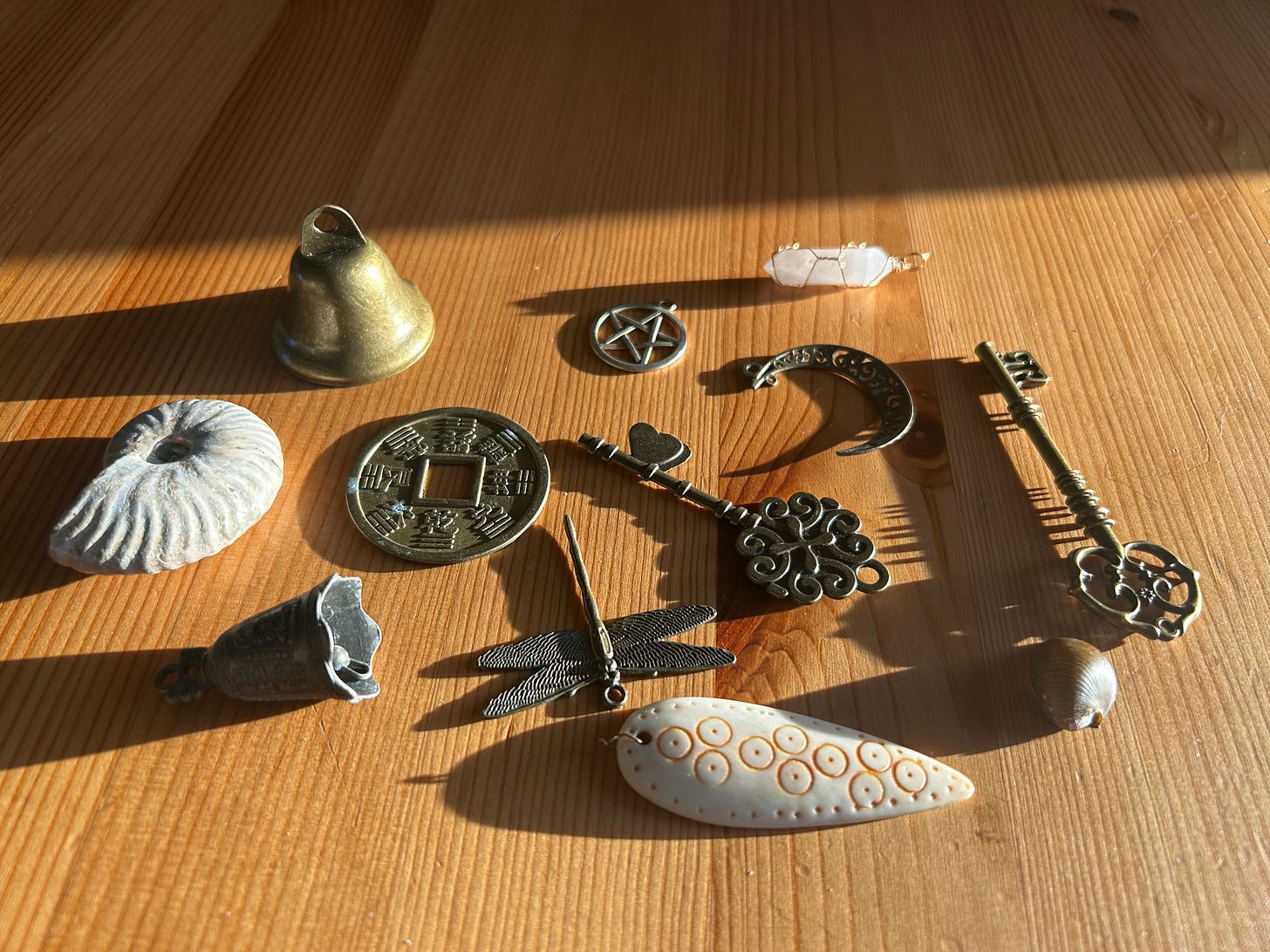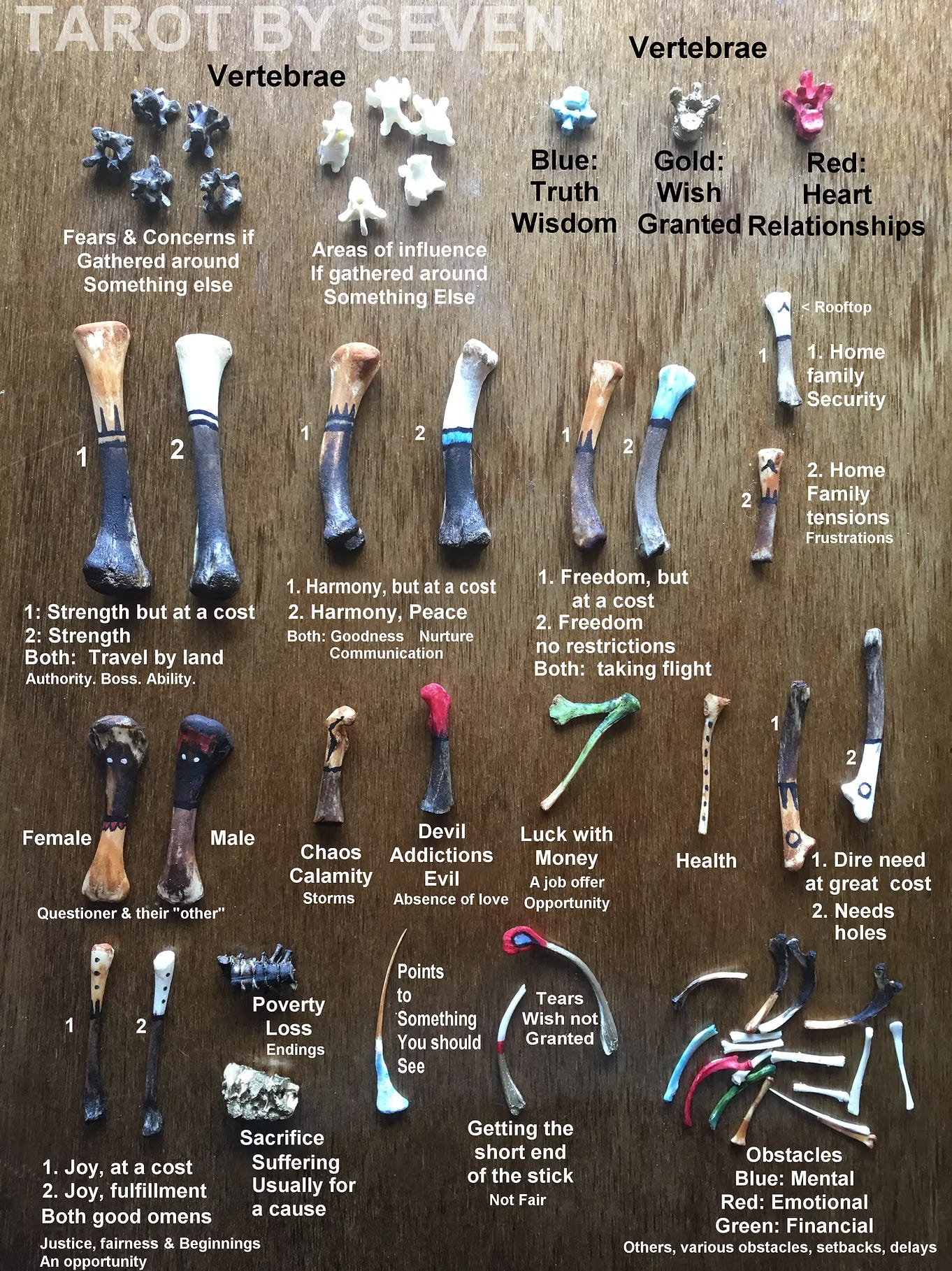Osteomancy- The Ancient Tradition of Bone-Throwing
Though our bones will return to the Earth as dust, what kind of magick is left behind? Does the spirit exist in this fleshy pink mound we carry in our heads… or does our essence lie in the bones?
When I first dug up my osteomancy set, I feared that I was excavating the bones of an infant… I quickly discovered that none of the bones resembled a human… I just watch way too much true crime.
In early March last year, an ex and I turned over six of our garden beds in preparation for a quaint herb garden. I’m the gardener for a homeless shelter, where residents are encouraged to grow and care for their own plants. They usually have one particular plant in mind, but I, unfortunately, have to tell them no on that one.
As we were digging, we stumbled across a few small bones. At first, they looked like discarded chicken drumsticks from the residents. Then, we dug up pelvic bones, vertebrae, scapulas, and ribs, stuff you definitely shouldn’t get your KFC buckets.
Something had been buried here.
I asked around with some of my co-workers who’d been there longer than me, just to make sure I wasn’t digging up someone’s Fido. No one knew why the bones were there, and no dogs or cats had died in the wings in several years, so there was no reason to have a burial (and definitely not in a raised garden bed… that’s crazy).
My best guess is a raccoon.
A raccoon possibly crawled into the garden bed at the height of summer when the plants were thick and bushy. He probably died and went unnoticed for a while until he was finally tossed around in the dirt for the next season, only for me to find him a few years later (we had a long gap between gardeners).
Nevertheless, I let my ex have a few smaller bones to make jewelry but told her we should keep the rest as our own osteomancy set. The bones were sent to us at the beginning of spring to symbolize new beginnings–and, indeed, there was quite a change soon after...
When we broke up, one of the first things we discussed was that she would keep the new Switch, but I got the osteomancy set.
I’ll take the bones over a Switch any day.
It felt like I was meant to find this set or that it had been directly sent to me. Even though I had always longed to practice osteomancy, something turned me away—an unseen energy.
I hadn’t practiced any form of divination in nearly a year and a half, not since I began writing my thesis centered around Nietzsche and Julian Huxley (brother of Brave New World’s Aldous Huxley; check out the article I wrote on that masterpiece). I spent a year studying whether or not “god” exists for hours each day, and the theory was wearing me thin. I felt out of touch and unaligned. I continue to feel this way sometimes, even today.
It’s a snowy day here in Appalachia, but spring is on the way. I’ve been revisiting my old poetry, spending more time in nature, and writing for a genuine audience, something I’ve rarely ever done. I’ve even read some tarot cards here and there in recent months, finding my way back to spirituality during times of duress.
So, I decided why the hell not, and did some cleansing rituals, grounded myself, and got to work on the research:
HISTORY
Osteomancy is an ancient form of divination in which practitioners toss a set of animal bones and interpret their meaning based on how they land. Osteomancers consider everything, especially the personal meanings of each object, orientation, closeness, and direction.
There is power in bones. After all, they were the original dice. Thousands of people roll the dice to test their fortunes every day. They shake them, bless them, blow on them for luck. We cheer and celebrate our good fortune when the dice lands just right. If they land on what we dread, our luck soon runs out. In this way, we carry on an ancient practice that has served our ancestors for generations and is now rooted in our modern cultural rituals without us even realizing it.
Before Galileo and Cardano introduced the concept of probability, the ancient people believed that the turn of the dice was determined solely by divine beings. The Sanskrit epic, Mahabharata, contains the first written records of dice use over 2,000 years ago. Much like oracles, dice were frequently used to predict the future. Ancient dice were made from bone, ivory, rock, alabaster, amber, and other materials. The ankle and knuckle bones of sheep or other domesticated animals were the most common, known in the Greek world as Astragaloi.
Humans have always been anxious to know their future and, even better, to know how to change it.
Osteomancy’s roots are hard to trace, but many historians believe the oldest practices took place in Asia, specifically China. Archeologists have uncovered some of the oldest marked “oracle bones” in Neolithic graves dating from around 6600-6200 BCE, most of which are tortoise shells.
Pyro-osteomancy was a popular form of bone divination worldwide, especially during the Shang dynasty. A pyro-osteomancer envisions the future by throwing a bone into an open fire and reading the cracks. The scapula bones, with their flat and wide surfaces, were the best to read, even resulting in their lesser-known form of divination: Scapulamancy. Turtle or tortoise shells were also quite standard in these practices.
Osteomancy practice wasn’t exclusive to Asia, though; it is by no means a closed practice. There’s evidence of diviners all over Eurasia, North America, and other parts of the ancient world. Most notable are the Indigenous peoples of the Eastern and Mistissini Cree and the Naskapi Innu. The Innu, in particular, used animal bones, mostly caribou, to determine their next hunting grounds. After throwing a caribou bone in the fire, they believed the lines would map their journey to a plentiful destination with more caribou to hunt (Speck).
Bone sacredness was abundant even outside of Osteomancy. We’ve seen a common trope throughout cinema and television: the evil lair always hosts a wide selection of hanging bones and human effigies. Unfortunately, Ashley Homes has determined these styles “out-of-date” (let’s petition for a comeback?), but hanging bones in and around tribal encampments was never much of a wide practice compared to Tibetan “sky burials” or excarnation of the dead.
These rituals tell us something about the magick in our bones. So many cultures chose to remove the flesh and bury just the bones. Everything else will fade: our skin, our muscles, our organs, even our hair (eventually). Though our bones will, after a prolonged time, return to the Earth as dust, they stick around far longer than the rest of us.
What kind of magick is left behind?
Does the spirit exist in this fleshy pink mound we carry in our heads… or does our essence lie in the bones?

GATHERING YOUR SET
Now that you know the history and magick behind bone-throwing, you may wonder exactly how the process works. For this article, I will stick purely to Osteomancy bone-throwing (no burning bones today, but maybe another time).
After educating yourself, you must find your osteomancy set. Not everyone will be able to find a complete set randomly. Be warned: building your osteomancy set from scratch will take time and patience—the gifts of nature do not come quickly!
I highly recommend finding the bones yourself, though I do not suggest picking up road kill (in some areas, it may even be illegal). Be well informed about handling animal remains, especially bird feathers. Some birds are protected on a spiritual and legal level. (If you are a Romanian practitioner, refrain from using crow and rooster bones and feathers—these are sacred animals!)
If you are an outdoorsy person or, even better, a forager, try to mirror Robert Frost and take “the road less traveled by.” You may find yourself stumbling upon a few bones, especially in heavily wooded areas (though, of course, be careful and don’t do this alone– at least let someone know where you are).
Be sure to use proper protection when dealing with animal remains.
Most importantly, remember to thank the animals and nature for what they have given you. If it is evident that the animal was buried, don’t go digging for someone’s pet. But if you stumble upon a few bones in nature, take it as a sign to give thanks and respectfully add them to your set.
A lot of vendors sell bleached and sterilized bones. If you’re purchasing from Etsy or a curio shop, ensure these bones are ethically sourced. Even though they are readily available, try to avoid using bones from the meat you bought from a butcher or grocery store. These animal lives were cut short by humans after suffering in factory farming conditions. The set may not be as sacred as finding them in nature.
For my set, I soaked the bones in water and diluted hydrogen peroxide for 24 hours to remove greasiness (if any). After soaking, I scrubbed the bones until they were a few shades lighter, and then I laid them down on a paper towel to dry out for a few days before beginning the practice.
I also like using a set of trinkets and other materials combined with the bones to add meaning and magick to my set.
DECORATING YOUR BONES
Practitioners of Osteomancy often assign deeper meaning and symbolism to their bones through markings that represent their cultural traditions. For my set, I chose Nordic runes (maybe one day I’ll write an article about the time I traced my ancestry back to Sæmingr, the supposed son of Odin and Skaði).
Marking helps when you have a lot of similar bones and can’t easily tell them apart. You may carve or paint your bones; some people even mark them with a Sharpie. Either way, find a symbol or alphabet that means something to you, learn the translations, and keep a cheat sheet nearby anytime you practice so you can quickly look up the meaning.
You should have a few distinct meanings in your bones: representations of man and woman, or a third if you choose. Items that remind you of family, close relationships, your dreams, childhood memories, even symbols of “positives” and “negatives.”
There are no rules when it comes to each bone’s meaning. Ultimately, assign the meanings that feel right after holding each piece and meditating on the messages that pop into your mind. Many practitioners will assign a bone or item representing “them” and always use this object during throws. Then, the reading is based on each item’s positioning to “you.”
You don’t have to use an item to represent you, instead you can focus on how close bones are to other objects, to you, and where they fall in the circle to determine the immediacy or intensity of their messages.
BEFORE YOU THROW
Educate Yourself
Read up more about the history and traditions in your cultural and spiritual sphere. Adapt the practice to best suit your needs while respecting the ancient art of Osteomancy.
Respect the Craft
Your bones deserve to be honored. If you use an altar, equip it with earth, air, water, and fire elements. The bone, then, could represent the spirit.
Respect and honor the animal and the earth. Thank them for their guidance every time you practice.
Guard Yourself
Cleanse your bones before using them EACH TIME
Sound Baths
Salt water spray
Smoke
Moonlight or Sunlight cleanse
Have a Good Headspace
Center yourself and breath before practicing.
If possible, practice outside.
HOW TO THROW
How you throw the bones (and possibly other items) depends on your preferences and comfortability.
In my osteomancy practice, I use an old Appalachian tradition. I gather a few bones or objects in my hand—just one hand—then I bump my hand against the table and release everything on my way back up. This is called “knocking the bones.” It ensures that the leftover energy in the bones gets “knocked” out before the reading, or it could also be a way to wake the bones up and say get to work!
Some people keep their bones in a bag or a tossing satchel and do it from there. Others use a bowl and swirl them around before dumping it onto a table. Whichever way you throw, I highly recommend having a clear surface and some cloth to prevent damage. Be careful not to throw bones too high; the goal is to land them softly.
As you’re throwing, think of it like a tarot reading and ask a specific question. You can definitely try a general reading, but these may be more difficult to decipher when first starting out.
HOW TO READ
To start, if you’re using an object to represent you, consider the positions of the bones in relation to that object. Same thing if you’re not using a self-representation, simply use your physical position in relation to the bones.
Go ahead and jot down some notes about their orientations, directions, and how far or close they are from you or each other.
Items that are nearby may indicate immediate concerns, while items positioned further away may operate in the background, be of little concern to the thrower, or represent unconscious messages.
Did any bones land on top of other objects? Are there any that are crossed over or objects pointing at one another?
In “yes” or “no” readings, bones that are crossed mean “yes,” and vice versa. Bones/objects that are barely touching could mean “maybe.”
An object on top of another could symbolize that whatever meaning you assigned is overshadowing the other. If multiple items are tangled together, this could represent conflicting interests, especially if they are surrounding the object that represents you.
The four directions could also play a role in the reading:
North: Stability, ancestors, family concerns, and health.
East: New beginnings, future fortune, communication, intellect (think moving forward).
South: Warmth, growth, harmony with self, happiness.
West: Often associated with death, darkness, moving backward, past influences, but could also mean harmony, autumn (rest), and freedom.
The types of bones and objects you use may hold specific meaning, that is also up for interpretation based on the meaning you’ve already assigned:
Skulls: Messages from the otherworld, intellect, magic, hidden knowledge. Or can represent the energy directly associated with the animal.
Vertebrae: Consider it the root chakra; these bones stabilize and provide structure. If this ends up far away from you in a reading, it may mean you require stability.
Ribs could represent strength, protection, or vulnerability, depending on how you interpret them (guarded heart vs. open heart).
Leg or Arm bones: Movement and action.
Claws/Talons: Defense, ambition, or needing to “grab hold” of something. If it is pointed toward another object, consider the opportunity it may be pointing to/away from.
Shells: Shells are the bones of the ocean. They represent emotions, the invisible world, and femininity.
Wood: Wood, the bones of the earth, can represent new growth, prosperity, a need to return to nature, or a desire to give thanks. It can also represent masculinity.
Coins: Fortune, obviously. Though, this may not mean money, per se.
Keys: Unlocking new doors, potential, new pathways in life.
Feathers: Messages, travel, and spirit. They can also be interpreted based on specific bird meanings.
Ultimately, osteomancy is like any other form of witchcraft or ritual. It takes time to develop your inner sense and ability to read whatever messages a divine force/universe/deity may be trying to send you. The more you throw the bones, the more you meditate on meanings, and the more you trust in whatever you believe, the stronger Osteomancer you will become.
So, take notes!
Meditate!
Cleanse your bones and altars!
Ask your deities/ancestors for guidance!
Respect the animal and nature!
As a personal preference, I never let anyone touch my set. I keep it sacred for myself and practice only in private. As you may soon find out, osteomancy is a deeply historical art and intense spiritual practice. You must form a close connection to your tools and trust in them to point the way.










So interesting & I feel like you've really taken care to deep dive into this in a way that I wouldn't have been privy to otherwise, looking forward to checking out the rest of your posts!
What a fascinating read! It definitely seems like you were right, those bones were meant to come to you! You've honored them in a way most wouldn't think to. Thank you for sharing!!